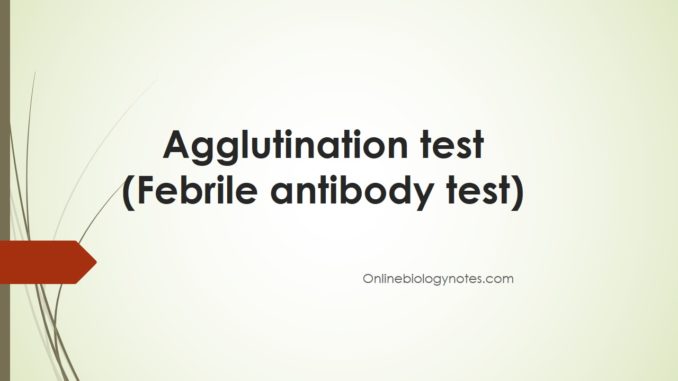
Principle:
The febrile antibody test is applicable in the diagnosis of diseases that produce febrile (fever) symptoms. Some of the microorganisms that accounts for febrile conditions are salmonellae, brucellae, and rickettsia. These organisms details febrile antigens, such as endotoxins, enzymes, and other toxic end products, elaborated that are used particularly to determine or exclude the homologous antibodies that are produced in response to these antigens during infection. In this technique, the antigen is mixed on a slide with the serum being observed. The presence of homologous antibodies in the serum is indicated by the cellular clumping, whereas it’s absence is denoted by no visible clumping. Only the febrile antigens and antibodies of Salmonella spp. is used.
The second portion of this experiment is designed to exemplify that agglutination reactions such as the febrile antibody test can be used to detect an unknown microorganism by means of serotyping. A specific antiserum prepared in a susceptible, immunologically competent laboratory animal is merged with a variety of unknown bacterial antigen preparations on slides. The bacterial antigen that is agglutinated by the antiserum is determined and confirmed to be the agent of infection. These tests are qualitative in nature and the quantitative result can be gained by performing the antibody titer test, which measures the concentration of an antibody in the serum. The patient’s serum is diluted by titration and the reducing concentrations of the antiserum are mixed with constant concentration of homologous antigen. The end point of test will take place in the test tube consisting the serum having the highest dilution showing agglutination.
Requirements:
- Cultures:
– Culture of Escherichia coli, Proteus vulgaris, Salmonella typhimurium, and Shigella dysenteriae. - Physiological saline (0.85% NaCl)
-Commercial preparations of Salmonella typhimurium H antigen, and Salmonella typhimurium H antiserum (antibody) - Bunsen burner
- Inoculating loop, Glass micro- scope slides
- 13 * 100-mm test tubes, sterile 1-ml pipettes
- Mechanical pipetting device, applicator sticks, glassware marking pencil, microscope, and water bath.
Procedure:Febrile Antibody Test
- Make two circular areas about 1⁄2 inch in diameter on a microscope slide with a glassware marking pencil. Label the circles A and B.
- Add 1 drop of S. typhimurium H antigen and 1 drop of 0.85% saline to area A. Mix the two with an applicator stick.
- Add 1 drop of S. typhimurium H antigen and 1 drop of S. typhimurium
H antiserum to area B. Mix the two with a clean applicator stick. - Pick up the slide, and with two fingers of one hand, rock the slide back and forth.
- Observe the slide both macroscopically and microscopically, under low power, for cellular clumping (agglutination).
- Indicate the presence or absence of macroscopic and microscopic agglutination, and draw a representative field of areas A and B in the Lab Report.
Serological Identification of an Unknown Organism:
- Prepare two microscope slides as in the earlier procedure. Label the four areas on the slides with the numbers of your four unknown cultures.
- Into each area on both slides, place 1 drop of S. typhimurium H antiserum.
- With a sterile inoculating loop, suspend a loopful of each number-coded unknown culture in the drop of antiserum in its appropriately labelled area on the slides.
- Pick up the slides and slowly rock them back and forth.
- Observe both slides macroscopically and microscopically, under low power, for agglutination.
- In the Lab Report, mention the presence or absence of macroscopic and microscopic agglutination in each of the suspensions. Also, mention the suspension that is indicative of a homologous antigen-antibody reaction.
Determination of Antibody titer:
- Place a row of 10 test tubes (13 * 100 mm) in a rack and number the tubes 1 through 10.
- Pipette 1.8 ml of 0.85% saline into the first tube and 1 ml into each of the remaining nine tubes.
- Into Tube 1, pipette 0.2 ml of Salmonella typhimurium H antiserum. Mix thoroughly by pulling the fluid up and down in the pipette. The antiserum has now been diluted 10 times (1:10).
- Using a clean pipette, transfer 1 ml from Tube 1 to Tube 2 and mix thoroughly as described. Using the same pipette, transfer 1 ml from Tube 2 to Tube 3. Continue this procedure through Tube 9.
- Discard 1 ml from Tube 9. Tube 10 will serve as the antigen control and therefore will not contain antiserum.
- The antiserum has been diluted during this twofold dilution to give final dilutions of 1:10, 1:20, 1:40, 1:80, 1:160, 1:320, 1:640, 1:1280, and 1:2560.
- Add 1 ml of the Salmonella typhimurium H antigen suspension adjusted to an absorbance of 0.5 at 600 nm to all tubes.
- Mix the contents of the test tubes by shaking the rack vigorously.
- Incubate the test tubes in a 55°C water bath for 2 to 3 hours.
- In the Lab Report, indicate the presence or absence of agglutination in each of the antiserum dilutions. Also, indicate the end point of the reaction.
Result interpretation:
- Positive test: Observation of visible agglutination in the suspension is considered positive result. However, antibody titer greater than 1:80 is considered significant positive.

